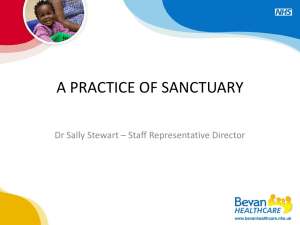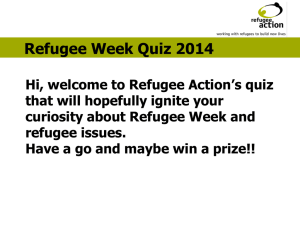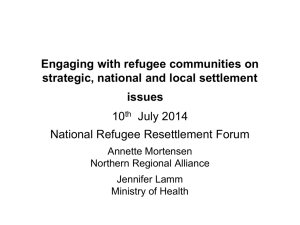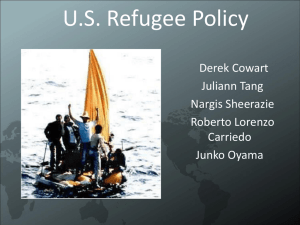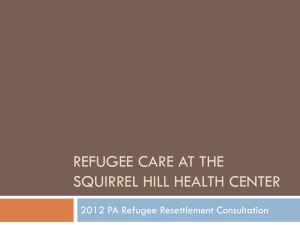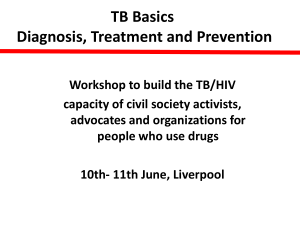Treatment and Prevention of Tuberculosis Among Refugees and IDPs
advertisement
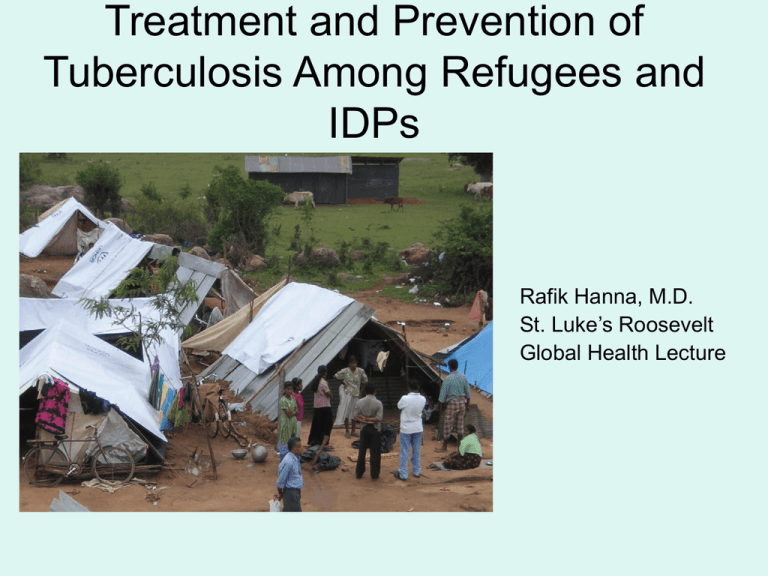
Treatment and Prevention of Tuberculosis Among Refugees and IDPs Rafik Hanna, M.D. St. Luke’s Roosevelt Global Health Lecture Statistics on TB • 1/3 of the world’s population infected with TB (latent), with a lifetime risk of developing active TB of about 10%. • In 2010, approximately 8.8 million incident cases of TB. • Incidence of TB (absolute number) has been falling since 2006. • 1.2-1.7 million deaths annually. • Of TB patients tested for HIV in the Africa region in 2010, 44% had HIV co-infection. • About 80% of all TB patients live in sub-Sahara Africa and Asia, where the majority of refugees and IDPs currently live. • In 2009, there was an estimated 9.7 million orphan children as a result of parental TB deaths. • India and China account for 40% of new cases of TB in 2010 (burden decreasing in both countries). • 11,182 reported cases of TB in the U.S. in 2010. Incidence of TB 2010 Prevalence of HIV in New TB Cases 2010 TB Incidence Rates 1990-2010 in High-Burden Countries TB Prevalence Trends and Forecast Basic Facts on Course of TB • In the natural course of the disease, among sputum smear (+), HIV (-) cases, 70% die within 10 years. • In patients who are culture (+), sputum smear (-), HIV (-), 20% die within 10 years. • Cure rates are approximately 90% for patients treated with anti-TB drugs. MDR-TB Case Prevalence Regional Trends in MDR-TB Stop TB Strategy Components of the Stop TB Strategy • Pursue high-quality DOTs expansion and enhancement. • Address TB/HIV, MDR-TB, and the needs of the poor and vulnerable populations • Contribute to health system strengthening based on primary health care. • Engage all care providers. • Empower people with TB, and communities through partnership. • Enable and promote research. Definition of TB Cases *XDR TB is MDR TB resistant to any FQ and one of three injectable aminoglycosides (capreomycin, kanamycin, and amikacin). Xpert-MTB/RIF • • • • • • • • New test for rapid diagnosis of TB. Cartridge-based nucleic acid amplification assay. Endorsed by the WHO in 12/2010. Developed by Cepheid, Inc., with UMDNJ (Newark), FIND; support – NIH, BMGF. Detects Mtb and mutations conferring rifampicin resistance from sputum samples. Sputum sample results in 100 minutes. Sensitivity: 1 sputum (98%) for smear (+) pulmonary TB; 1 sputum (72.5%), 2 sputums (85.1%), 3 sputums (90.2%) for smear (-) pulmonary TB. Specificity: 99.2%. Lab services, microscopy, and culture still needed to monitor treatment progress and to detect resistance to drugs other than rifampicin. Constraints of Refugee and IDP Situations • Marginalization of refugees and IDPs, sometimes with more attention needed to the more vulnerable groups. • Malnutrition and other acute infectious diseases. • Breakdown of normal systems of screening and universal precautions. • Social, political, and cultural disruption. • Difficulties for planning longterm programs. • Refugees and IDPs held in suspicion as being agents of epidemic introduction. Characteristics of TB • TB continues to be a disease of poverty. • Poor living conditions, poor hygiene, overcrowding, inadequate ventilation, and malnutrition favor the spread of the disease. • Other risk factors include HIV, DM, ESRD, Vitamin D deficiency, smoking, silicosis, alcoholism, adult males, malignancy, steroid therapy, anti-TNF medications, genetic variants. • Though much has been learned about TB transmission, much still remains to be unknown regarding the transmission pathway. • Vaccine-efficacy is very limited at this time (BCG efficacy in young children to prevent miliary TB and tuberculous meningitis). Characteristics of TB • Among refugees, there is often the additional loss of community structure and regular access to health care. • Many of these aforementioned factors thereby make refugee and IDP situations possible ideal grounds for the spread of TB. • In the 1990s in Kenya, the incidence of new patients with infectious TB in refugee camps was four times the incidence of the local population. This placed an extra burden on the Kenyan TB program. • Additionally approximately 200 million people live in countries affected by complex emergencies (a humanitarian crisis in a country, region or society where there is total or considerable breakdown of authority resulting from internal or external conflict and which requires an international response that goes beyond the mandate or capacity of any single agency and/or the ongoing United Nations country program). Dilemma of TB Treatment in Refugee Situations • Transience of the population with unforeseen mobility. • Short-term mandates of most relief agencies, resulting in insufficient commitment in terms of time and resources. • Security problems leading to poor compliance and withdrawal of health agencies. • Limited financial resources in post-emergency phases. • Desiring to provide no better health care for refugees than those available to local citizens. • Ineffective programs may do more harm than good (keep infectious patients alive for a small amount longer, remaining as sources of spread, yet still dying from the disease; creating MDR TB) TB Program • Not to be implemented in the acute emergency phase (death rates are <1 per 10,000 population per day). • Data from the refugee or displaced population indicate that TB is an important health problem. • Basic water, nutrition, shelter, and sanitation needs are being met. • Essential clinical services and basic drugs for common illnesses are available, with these services being accessible to a large part of the population. • Objective is detect at least 70% of TB cases existing in the population and to cure at least 85% of them. TB Program Key Elements • Political commitment to TB control with sustained financing. • Case detection through quality-assured bacteriology (recent approval for Xpert-MTB/RIF use may play a role). • Standardized treatment with supervision and patient support. • Effective drug supply and management system. • Monitoring and evaluation system and impact measurement. Steps in TB Program Implementation in Refugee/IDP Settings • • • • Assess the burden of TB among the population. Determine whether the initiation criteria have been met. Raise awareness among host and refugee populations Become aware of the national treatment (NTP) regimens being used. Explore links with the local health system, at least to use facilities such as x-rays. • Secure funding to admit patients into the program for a 12-month period and for a total commitment of 18 months. • Determine staffing requirements, patient accomodations, existing lab resources, recording system, and methods for monitoring and evaluation. Training Staff for a Successful TB Program • Staff must have basic knowledge of TB. • NTP, WHO, NGOs may be a source of such trainers. Also consider possible experienced staff among refugees/IDPs. • Primary healthcare workers must be aware of 1st signs of the disease and the process of diagnosis. • Lab staff must be familiar with quality control and record management. • Records must include registering all TB suspects, TB lab patient registry, individual patient records, and all those treated. • Repeat smears at 2, 5, and 6-8 months of treatment. Key Steps of TB Program Impementation Diagnosis of TB in Adults • The most important symptom in the identification of TB in adults is cough of duration longer than 2 weeks. • Must identify smear-positive pulmonary TB cases since they are main source of infection in the community. • Patients should provide 3 sputum samples in 2 days and treat if positive. • If the initial 3 smears are negative but pulmonary TB is still suspected, give amoxicillin or cotrimoxazole for at least one week and reexamine 3 new samples if symptoms persist. Criteria for Diagnosis of Pulmonary TB in Adults WHO Recommendations for Diagnosis of TB in HIV-prevalent and Limited Resources Treatment Regimens of TB • • Based on standard combinations of five essential TB drugs: rifampicin, isoniazid, pyrazinamide, ethambutol, and streptomycin. Each regimen consists of two phases: 1. 2. • An initial (intensive) phase: This phase lasts 2–3 months during which 3–5 drugs are given daily under direct observation to reduce the number of TB organisms to very low levels. A continuation phase: This phase lasts 4–6 months during which 2–3 drugs are given 3 times a week under direct observation or, in some cases (e.g. during repatriation of refugees), 2 drugs are given daily for 6 months unsupervised, in a fixed-dose combination form. Actually swallowing every dose of rifampicin-containing treatment must be directly observed by a health worker, or a trained community member. Fixed-dose Drug Combinations Treatment Categories of TB Recommended Drug Dosages Dosing Schedules of New Cases using fixed-dose combination drugs Definition of Outcomes Special Considerations • Pregnant women may be treated with the same regimen as others, except for streptomycin because of toxicity to the fetus. • Women breastfeeding should receive a full course of TB treatment. All TB drugs are safe in breastfeeding. The infant of a smear-positive mother should receive INH. • OCPs are likely to be ineffective while taking rifampicin. TB in Children • The greatest likelihood of children developing TB disease after infection occurs within 1 year and most comonly in infants and children under 5 years of age. • The most common type of TB in children is extrapulmonary TB. • Pulmonary TB Diagnosis: contact with smearpositive pulmonary TB case; respiratory symptoms >2 weeks not responding to antibiotics; weight loss; positive TST. • If a close contact active TB case occurs, children under 5 should be treated with 6 months of INH. TB Treatment in Children Repatriation • Stop recruitment of new patients. • Coordination between the two programs and the NTPs of the two countries. • Set up administrative systems for transfer of patient cards and notes (patients should have personal cards with them). • Harmonize treatment protocols. • Supply of drugs for transfer process. • Pick up at border for close follow up in the country of return. Bibliography • http://www.cdc.gov/tb/statistics/ • WHO Global Tuberculosis Control 2011 • WHO Tuberculosis Care and Control in Refugee and Displaced Populations 2nd edition 2007 • http://www.who.int/bulletin/volumes/85/8/06037630/en/index.html • Lawn SD, Zumla AI. Tuberculosis. Lancet. 2011 Jul 2;378(9785):57-72 • http://www.jhsph.edu/bin/k/c/Pages_from_Chapter_7_.pd f. • Germaine Hanquet. MSF. Refugee Health: An Approach to Emergency Situations. Malaysia: Macmillan, 1997.



